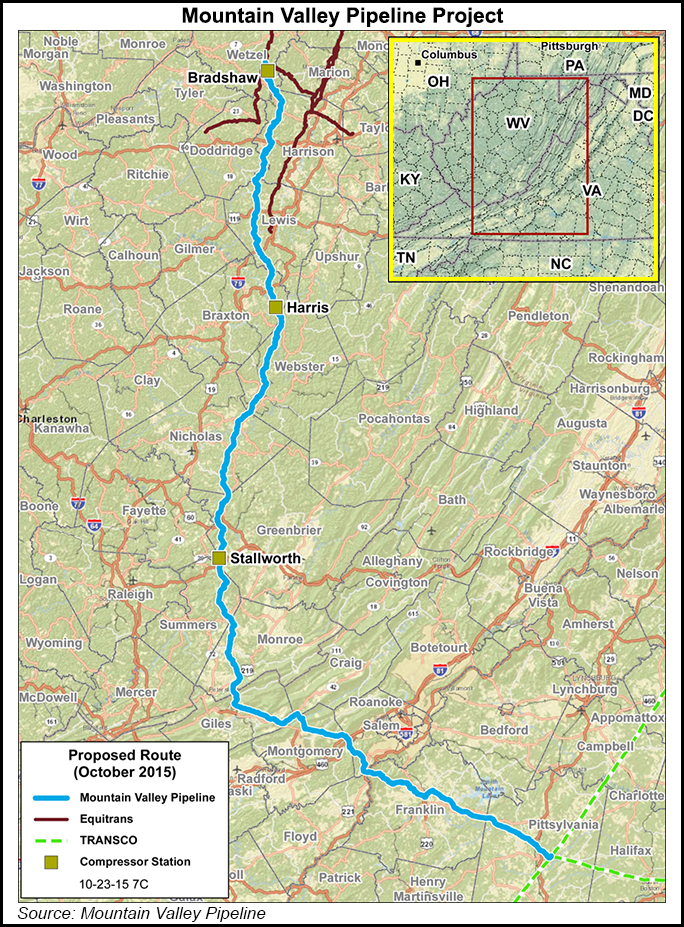FERC DEIS for Mountain Valley Pipeline Needs Work, Federal Agencies Say
FERC’s draft environmental impact statement (DEIS) for the proposed Mountain Valley Pipeline LLC (MVP) is incomplete or insufficient, a number of participating federal agencies told the Commission last week.

In recent filings to the project docket [CP16-10], officials with the Environmental Protection Agency (EPA) and the Department of the Interior (DOI) offered unfavorable assessments of the Federal Energy Regulatory Commission’s DEIS for the Appalachian Basin-to-Southeast MVP and the related Equitrans Expansion Project.
FERC issued a DEIS for MVP in September, paving the way for completing the project’s environmental review and eventually deciding on its certificate application, but EPA and DOI both characterized the document as lacking critical information for participating stakeholders.
EPA wrote that it “has concerns regarding the purpose and need, alternatives analysis and a number of important topics for which information is incomplete.”
DOI submitted analysis from a number of agencies under its umbrella, including the National Park Service (NPS), the Bureau of Land Management (BLM) and the U.S. Geological Survey (USGS).
“In general, DOI bureau review has resulted in the conclusion that the current DEIS lacks sufficient information to perform adequate analysis of impacts to DOI resources,” DOI said.
The NPS said, for example, that it “believes the DEIS was released for public comment prematurely and without the information necessary to complete meaningful analysis of impacts.” NPS criticized what it described as a lack of analysis of the potential impacts MVP could have on the Appalachian National Scenic Trail, which the pipeline plans to cross.
The BLM requested “a revised draft for portions of the DEIS,” citing what it described as missing analyses or information still in draft form that would necessitate a supplemental DEIS.
DOI also included in its filing comments from the U.S. Forest Service, in which that agency listed several detailed requests for additional information, along with other items it classified as “previously requested information that remains outstanding.”
The EPA, meanwhile, echoing several other agencies, criticized FERC’s approach to analyzing alternatives to the project.
“The DEIS does not analyze alternatives beyond the applicant’s preferred alternative in detail,” EPA wrote. “EPA recommends that FERC provide detailed analysis on system and route alternatives, and further consider collocation opportunities and develop alternatives which further avoid and minimize impacts to important project area resources.”
The agency also called on FERC to broaden its consideration of cumulative impacts. Saying FERC’s current approach “uses a narrow geographic and temporal scope,” EPA said the Commission should “improve public understanding of cumulative impacts” and “describe the inter-related network of existing and proposed pipelines and associated impacts” in its environmental review.
EPA noted that FERC has asked the project backers to submit additional information relevant to the environmental review after the release of the DEIS. EPA said that “although this information has been or will be posted to the docket which is publicly accessible, EPA is concerned that without official notification, the public may not have had an opportunity to fully comment on this material. It is not apparent within the EIS how FERC intends to include public participation and comment on these subsequent filings.”
The agency comments on MVP’s DEIS come after calls from various groups for FERC to prepare a supplemental DEIS — and lengthen the review process — for the PennEast Pipeline, the Nexus Gas Transmission project and the Atlantic Sunrise expansion, respectively.
MVP spokeswoman Natalie Cox told NGI that the pipeline’s developers have been working “to determine and design a route that will protect environmentally sensitive areas, preserve cultural and historic resources, as well as have the least overall impact to landowners and communities.”
“…The updates and changes that occur throughout the process are intended to enhance and refine the Project, and often times, these enhancements are at the request of landowners, local officials, interested community members, and agencies,” she said.
“The issuance of [the DEIS] reflects those efforts and offers an opportunity to provide additional information and comment from interested parties as well as the project team. By its very name, the DEIS is a draft” review document “intended to elicit public comment that will be addressed in the FEIS. The FERC process has provided, and will continue to provide, the public with a meaningful opportunity to review and comment on the project’s information.”
MVP calls for construction of a 301-mile, 42-inch diameter pipeline with 2 million Dth/d of transport capacity, and includes three new compressor stations with a combined 171,600 hp. The pipeline will begin in Wetzel County, WV, and travel southeast to an interconnect with Transcontinental Gas Pipe Line Compressor Station 165 in Pittsylvania County, VA. The project is a joint venture of EQT Midstream Partners LP, NextEra Energy, Con Edison Gas Midstream LLC, WGL Midstream, Vega Midstream MVP LLC and RGC Midstream LLC.
The Equitrans Expansion Project, proposed by a wholly-owned affiliate of EQT Midstream, would add 600,000 Dth/d of north-south capacity in Pennsylvania and West Virginia through approximately eight miles of various diameter pipelines in six segments across Greene, Allegheny and Washington counties, PA, and Wetzel County, WV.
© 2024 Natural Gas Intelligence. All rights reserved.
ISSN © 2158-8023 |
